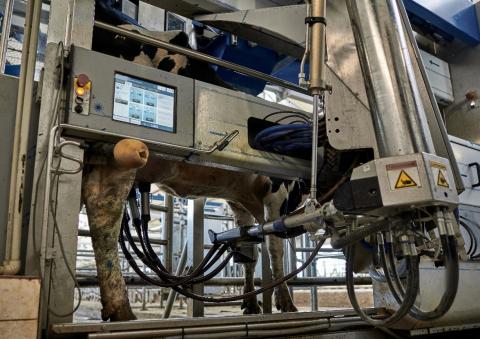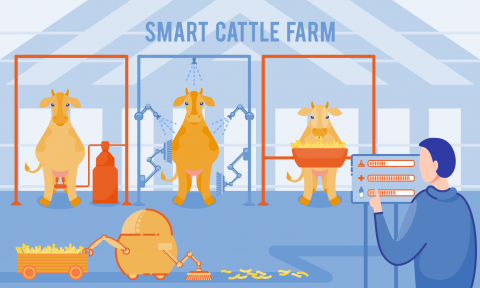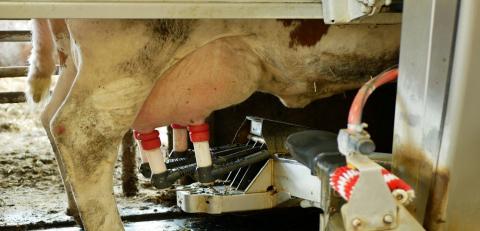5 August 2020
Dr David Cutress: IBERS, Aberystwyth University.
- Robotic milking systems are becoming ever more common within the UK and globally
- Whilst production and economic gains are a key reason for robotic milking system uptake, farmers should also increasingly consider the welfare outcomes
- Decisions on various aspects of these systems, particularly barn layout strategies, can have huge welfare effects on cattle involved and should be considered carefully
Introduction
Robotic milking systems (RMSs) sometimes referred to as automatic milking systems (AMS) are a form of precision livestock technology that was largely designed to combat issues surrounding the lack of available labour on European farms. The first systems became available in the early 90s in Europe, uptake has since continued to rise with current estimations of presence on around 1,000 farms in the UK (approximately 10% of all dairy farms). Such adoption rates match well with Canada (where adoption didn’t become common until the early 2000s) but are half that of most other European countries (Table 1). The main benefits of RMSs are the observed increases to productivity and profitability through improved labour efficiency and milk production and suggested improvements on animal welfare and ethical treatment. Where milk production is concerned studies have noted between 2 - 12% increases in milk yields with RMSs, due largely to increased frequencies of milking achieved in comparison to twice a day conventional systems (this particularly pairs well with higher-yielding cows). Briefly, RMSs involve a chamber/box-based unit with radio-frequency identification (RFID) detection (to detect individual cows and decide if they need to be milked based on time of their previous visit and other status information) and a robotic arm system which uses sensors to detect individual teats of the udder and apply teat milking cups automatically. Milking occurs in a per quarter manner and following successful milking RMS gates open to allow the cow to leave and the system self-cleans before the arrival of the next cow.
The complications with RMSs relate to cattle incentives to be milked, as studies have shown that a cow’s inherent motivation to be milked is low and that feed motivations make this far stronger. As such RMSs require specifically designed or retrofitted barn environments to traffic cows specifically towards RMS cubicles. The two main systems for this being free cow traffic, where cows can freely move between feed, rest, water and milking areas at will or guided/forced traffic (some intermediate traffic strategies use elements of each). Guided traffic systems can be feed first or milk first and require cows to pass through the milking robot before they can then access feed or other areas. These systems are often facilitated via one-way gates or in some cases RFID responsive gated systems, ensuring cows travel through areas only as desired. Farmers considering adopting this technology not only have to consider the equipment costs of around £120,000 for an RMS unit (which can milk between 50 – 80 cows depending on breed and make of system. With maximum suggested capacities of 2-3 units for herd sizes up ~200 cows), they also have to consider shed retrofitting and adaptation costs or even new shed costs which can be substantive. Larger herds may struggle to see the benefits of RMSs, however, newer technologies in the form of automatic rotary systems which can perform up to 1,600 milkings (sufficient for 3 visits of 500+ cows per day) may act to facilitate larger herd sizes but will not be discussed as part of this article.
This article will not focus on the production or profitability aspects of this technology which have been readily studied and can be difficult to assess long term as they require regular updating as and when systems improve and change. Instead, the focus will be the animal welfare effects which occur with RMSs as there is increasing interest from consumers that their food products be produced in high welfare ethical ways. Farming Connect demonstration farm Graig Olway is a Welsh dairy farm, utilising RMSs, that is particularly looking at health and welfare of their cows within this system. They hope to improve lameness as this can have an even higher impact on RMS scenarios compared to traditional milking.
Table 1. RMS adoption rates (% of total dairy farms in each country, rounded to nearest 0.5%) taken from Eastwood and Renwick 2020 paper
Stress response
High stress is detrimental to animal health status in various ways and against the five freedoms of animal welfare (where freedom from fear and distress is noted), there are also knock-on effects of stress which lead to reduced production efficiencies. Comparisons of the stress levels of cows from traditional parlours to RMSs have been performed utilising stress responses such as heart rate, maximum plasma adrenaline, noradrenaline, cortisol present in milk and increased movement (stepping and kicking). To date little evidence of increased stress levels have been found, however, there is evidence of higher stress levels in cows in the process of adapting to RMSs which then rapidly reduce following initial training session with the system. Furthermore, where farmers can house cows in a barn with an RMS unit in advance to acclimatise, particularly those with calves, then training periods and stresses involved appears to be reduced. There is also some evidence that suggests an increased stressed state occurs where forced/guided traffic RMSs are utilised compared to parlour systems which are not evident when free traffic RMS comparisons are applied.
Social hierarchy
RMSs are heavily influenced by linking the milking process to a desire for feed, with many systems requiring transition through an RMS cubicle to gain access to feeding areas or to gain specific concentrate supplements. This produces an environment where cows of a higher social rank enter the system first to access feed whilst lower-ranked cattle may have longer waiting times within a waiting area before they can access the RMS and then access feed. Research has suggested that large waiting areas immediately proceeding the RMS are key to decreasing social competition and that forced traffic systems have a negative effect on low ranking cows compared to free traffic systems (see table 2). Other studies have noted the reduction of low-rank cow waiting times by including more than one RMS cubicle per pen providing opportunities for lower rank cows to avoid direct competition with higher rank cows, furthermore, this reduces issues of RMS downtime during daily or routine maintenance. RMSs layout is important to alleviating social rank issues and incorrect layout can harm welfare, with knock-on effects seen on the efficiency of the RMS as a whole as milking interval times increase leading to lower milk yields.
Table 2. Summary of differences between free and guided traffic in RMS herds
Natural behaviour modifications
RMS behavioural changes can be both positive or negative and as such some should be encouraged whilst others require strategies aimed at reducing their impacts. Behavioural changes which occur concerning the milking process are varied and include changes in the number of times milked and the time spent being milked. A generally consistent factor of all RMSs is the per quarter attachment and detachment of teat cups, this can be considered a far more natural milking experience for cows as it more closely resembles natural suckling from calves and reduces risks associated with over milking (see health and welfare). Both free traffic and guided traffic systems lead to higher numbers of daily milkings compared to traditional methods, with many systems showing averages between 2.5 and 2.8 visits per cow per day compared to twice a day traditionally. Essentially an RMS offers more freedom and choice to cattle and has been demonstrated, largely, to maintain their diurnal natural behaviour with most milking occurring between 7 am and 10 pm. However, behavioural modifications are still influenced by human managerial actions such as feed delivery or push up, particularly in guided traffic systems where cows must be milked before gaining access to feed. Furthermore, with diurnal behaviour, welfare concerns are noted with regards to lighting levels in indoor situations, with too high lighting levels reducing resting behaviours observed and too low reducing milk yields achieved with RMSs. Importantly free traffic provides higher animal welfare and freedom of choice than guided traffic and also seems to reduce negative social hierarchy effects leading to boosted milk production overall per cow. The inclusion of parallel railings placed on the entrance of the RMS cubicles to separate cows was shown to reduce negative (bullying) behaviours whilst also increasing milk yields. Generally speaking, a large behavioural/welfare modification that occurs with RMSs is the bias towards indoor housing of cows as opposed to more natural pasture-based management. Pasture systems are present and can be successful, but these often lead to increased challenges including traffic flow bottlenecks in fetching cows for milking, observed difficulties in fetching cows effectively and increased labour requirements which can limit the benefits of the system overall. Fetching for milking is often overcome with feed incentives or in some instances training to respond to audio stimuli, both strategies inherently alter natural behaviour and can increase stress and opportunity for negative hierarchy behaviours if RMS barn layouts lead to long wait times to be milked.
Selective Breeding
RMSs have led users towards selective breeding of cattle for particularly beneficial traits within these systems, whilst this technically is not a direct welfare concern potential ethical issues surround this practice, though breeding of cattle to accommodate human requirements is a well-established practice. Breeding for improved RMS efficiency includes; the breeding of cows with the correct udder conformations to facilitate easy robotic identification and minimise failed milking cup attachments (which can occur in up to 15% of a herd), breeding cows that can transition to RMSs more easily and the breeding of cows with higher milking speeds. Increased milking speeds facilitate the processing of more cows per pen and, therefore, the stocking of pens with greater numbers to achieve higher production values. Interestingly, despite a low level of significance, and a conflict between various trials, there is some evidence that faster milking cows have lower levels of somatic cells in their milk suggesting some possible beneficial protection from udder health issues would be conferred. It is important to note that not only will a selection of any herd on transitioning to RMSs fail to have correct robotic teat attachment, a selection will also fail to be trained to adapt to the system in general (requiring constant fetching), this leads in many instances to higher culling values of otherwise perfectly healthy cattle.
Health and disease management
In a recent study of 200+ producers using RMSs it was shown that 66% actively changed their health management plans based on the increased data provided by RMSs compared to previous traditional systems. Furthermore, 80% of these producers also noted it was easier to specifically detect illness using RMSs (via the integrated health monitoring software) than in traditional milking, with reductions in clinical mastitis cases being observed. Whilst software and automation with RMSs offer the potential to detect illness with minimal labour input it is important to note that farmer observation and expertise are still essential. RMSs flush teat cups between cow visits to reduce bacterial spread and mastitis, however, system sensors struggle to effectively clean teats or recognise dirty teats which could be detrimental to mastitis prevention. Whilst technologies are developing to combat this issue other studies have noted this risk to be far higher in indoor housing systems as opposed to grazing systems, as such, it is suggested that farmers should place a higher priority on the hygiene of indoor housing environments in reducing teat infection risks with RMSs. Furthermore, per quarter teat cup detachment in RMSs following detected drops in milk flow prevents overmilking this alongside the ability to detect milk conductivity, colour and somatic cell count per teat all assist in reducing mastitis and intramammary infection prevalence over traditional milking which looks at the udder as whole.
RMS data have also been linked to the ability to detect cattle lameness, with RMS software alerting farmers to cows which have failed to enter the RMS cubicle in a certain period. This can act as an immediate prompt to assess individual cattle for early disease or lameness symptoms as lameness has been repeatedly shown to reduce cow visits to be milked in RMS units. Furthermore, RMSs incorporate pressure plates in their base to facilitate correct attachment of teat cups and this has been noted, in multiple studies, to be amenable to adaptation to detect differential pressures applied by each leg of a cow to further assist lameness detection and treatment. The nature of a barn’s layout for RMSs functionality also integrates well with the application of many precision livestock monitoring systems due to cows having certain “checkpoints” they regularly move through, these can act as locations where data collection devices are located to upload data on aspects such as oestrus/fertility, movement frequency and many others. As well as this, certain technologies such as cattle 3D imagery for health monitoring, carcass quality assessment, feed intake assessment and lameness detection could likely be incorporated as part of the fixed environment inside an RMS cubicle. The data from precision livestock devices could go towards improving health management plans and improving overall health and quality of life of cows involved. Finally, the ability to analyse data changes in milking for individual cows over time allows accurate management strategies to be applied to match cow milking cycles, for example, to reduce milking bouts during dry periods to further reduce intermammary infection risks whilst subsequently improving lifetime milk yields and productivity achieved per cow.
Summary
The adoption of RMSs in the UK is relatively low, particularly in comparison to Europe, but demonstrates an increasing trend of uptake. Whilst generally the beneficial aspects of RMSs are known, including increased productivity with reduced labour requirements, it is becoming increasingly important in the current climate to consider these benefits alongside specific animal welfare concerns. On the whole, RMSs tend to demonstrate greater animal welfare benefits than the traditional parlour milking alternatives, however, much of these benefits revolve around the correct use of barn infrastructure. Generally, when animal welfare aspects are improved in RMSs there is a subsequent improvement of productivity associated, this should act as a good incentive for those wishing to take up RMSs in the future to ensure they do so in the most ethical and animal welfare beneficial manner.



